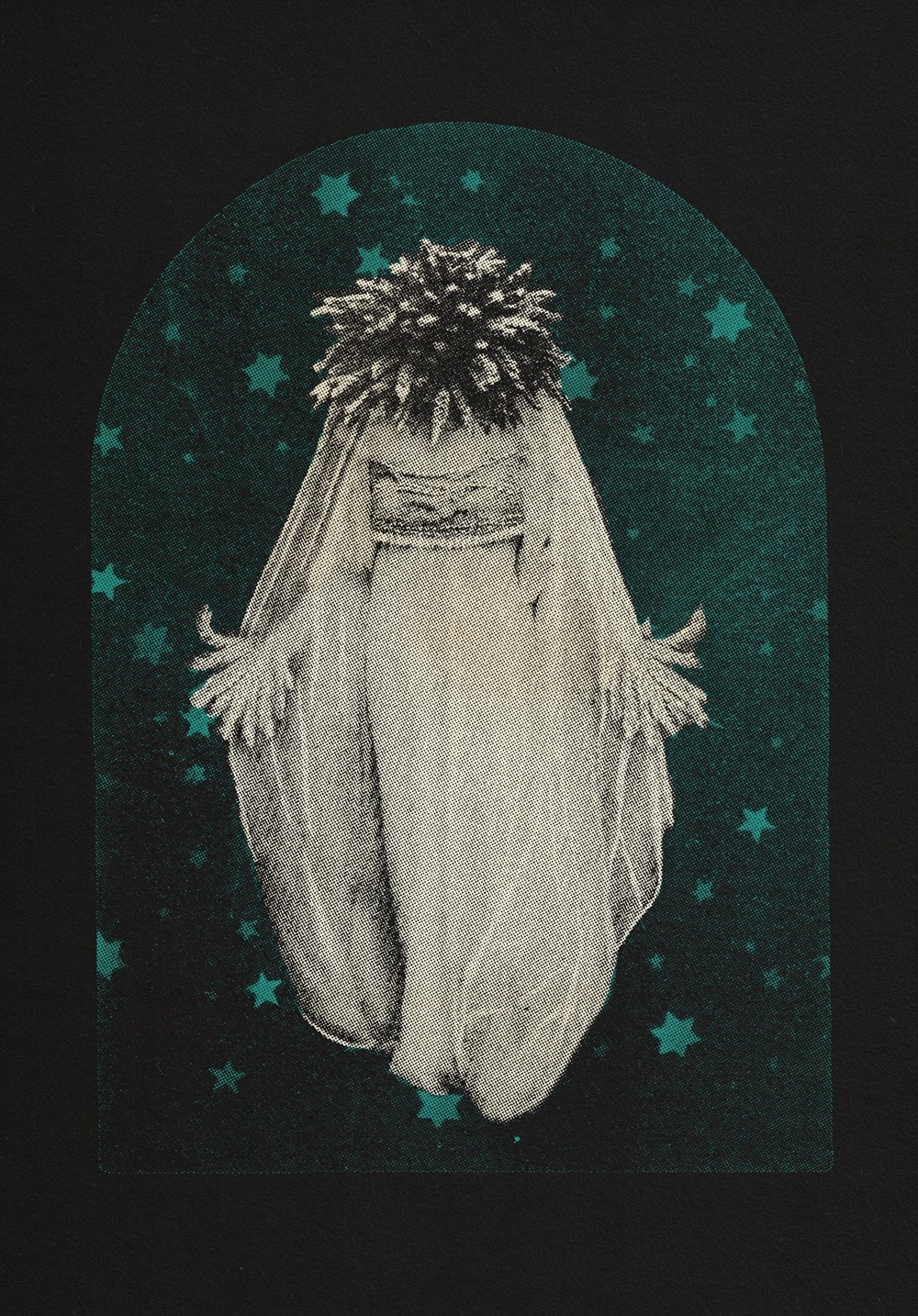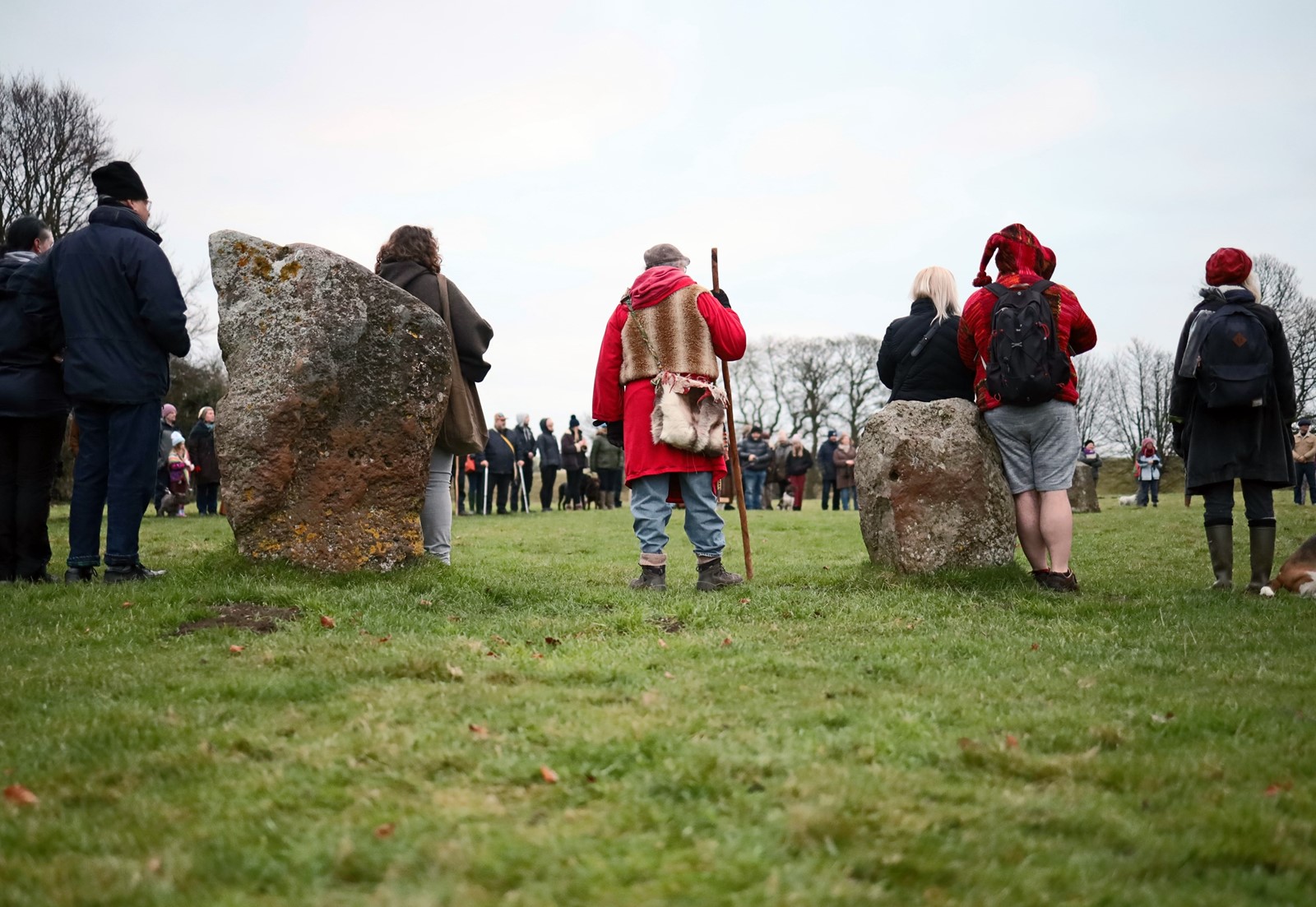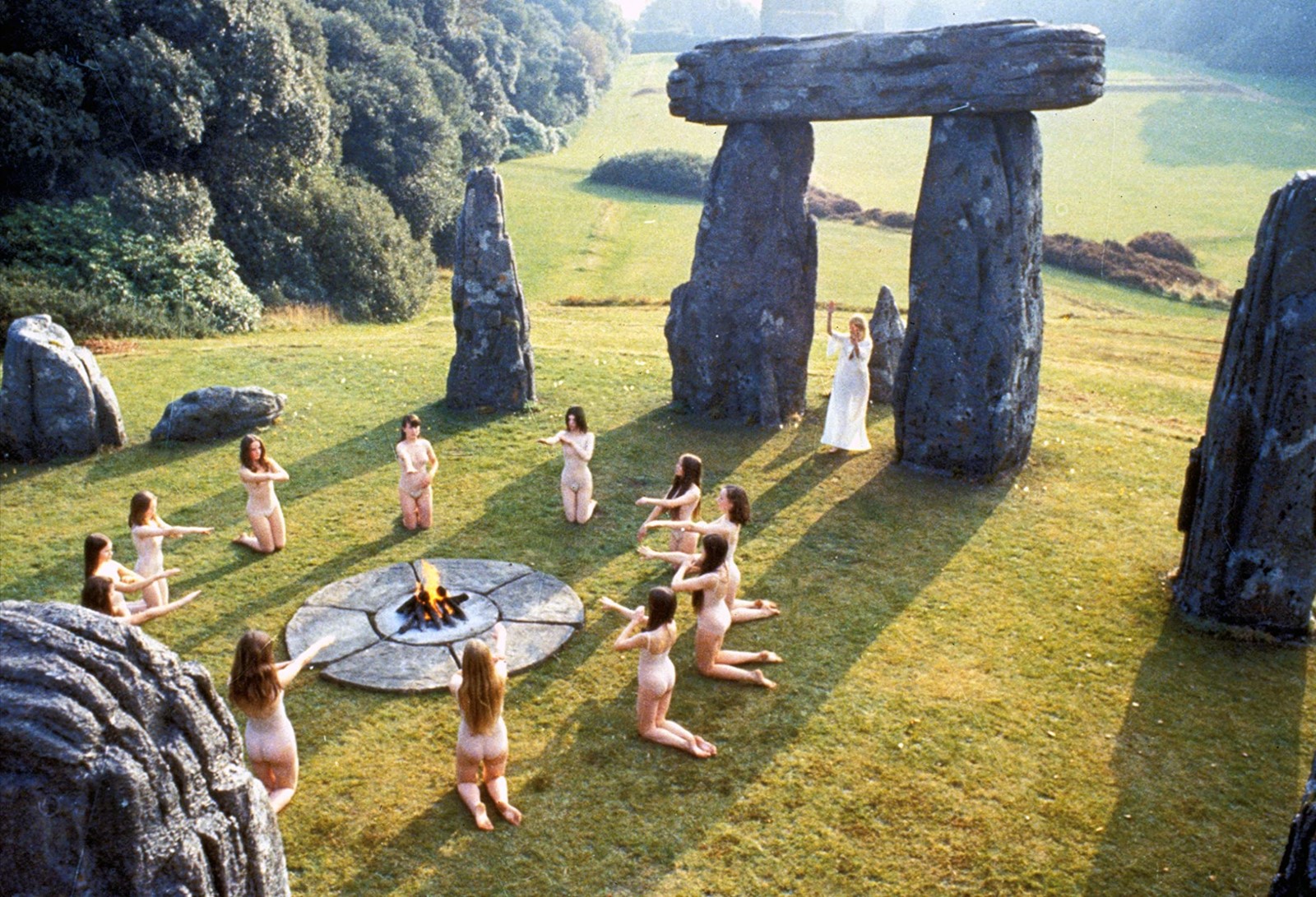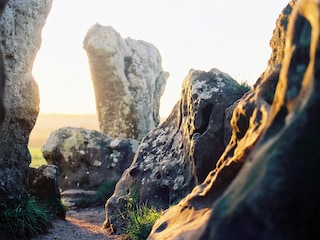50 years after The Wicker Man, Christianity is waning and neo-Pagan beliefs are on the rise – here, we talk stone circles, online spirituality, and anti-capitalist mysticism with the creators of Weird Walk and Hellebore
Introducing Horror Nation?, a new season from Dazed about the current state of the UK from the perspective of the young people who live here. Over the course of this week, we will be celebrating the good that is happening all across the country – the culture and the creativity, the artists and the activists, the positive forces for change. But we will also be confronting the reality that life is getting increasingly challenging for British youth, and that Britishness itself is in flux, or even crisis. Stay with us as we lift the lid on modern Britain and ask whether this really is a horror nation.
The last five decades haven’t been kind to Sergeant Neil Howie, the ill-fated policeman tasked with searching for a missing girl on the remote island of Summerisle in The Wicker Man. Between Britain’s rising ACAB sentiments and its declining belief in “the life eternal, as promised to us by our Lord, Jesus Christ” (the kind Howie invokes, as he’s led to the site of his fiery death) many of us are more likely to sympathise with the island’s maypole-dancing, fire-leaping Pagans, in 2023, than the moralising authority figure who arrives to interrupt their May Day celebrations. Life on Summerisle looks idyllic, and its inhabitants (good-humoured fishermen, sex-positive schoolteachers, the pub landlord’s beautiful daughter, and the charismatic Lord Summerisle) outfox Howie with neo-Pagan pranks at every turn.
We’re supposed to enjoy Summerisle’s mockery of the policeman’s Christian prudery, and it’s not entirely clear whether our allegiance is supposed to change at the end of the film, when he’s dressed as a Fool and ritually slaughtered – whether we’re supposed to repent and clasp our hands in prayer as Howie recites Psalm 23, or link arms with the islanders and join their rendition of the mediaeval folk song “Sumer is icumen in”. On the 50th anniversary of Robin Hardy’s cult classic, the answer to this question is even more ambiguous, as British Christianity wanes and Pagan beliefs are on the rise.
In 2021, the UK Census marked a significant moment in the nation’s religious history. For the first time since records began, less than half of the population of England and Wales described themselves as Christian, with a decrease of more than 13 per cent since 2011. At the same time, 95,000 described themselves as believers in Paganism, Wicca, or Shamanism, up from around 70,000 in 2011, and 42,000 in 2001. Admittedly, the numbers still pale in comparison to Christianity, but the tide does appear to be changing, driven in part by environmental concerns and the failure of existing institutions to deal with the dissociative malaise that’s come to define life in the early 21st century.
Released in 1973, The Wicker Man has been reanimated by this shift, becoming a cultural focal point of the neo-Pagan movement alongside its folk horror forebears like Witchfinder General and The Blood on Satan’s Claw. At the same time, a wave of new media offers a way into the movement via TikTok, music, and independent zines, imagining alternate futures with an eye on the Old Ways.
Maria Pérez Cuervo, the creator of Hellebore – a small press and zine devoted to British folk horror and the occult – first began exploring alternate forms of spirituality as a way to push back against her conservative Catholic upbringing in Spain. Books like The Third Eye (the 1956 hoax biography of a Tibetan monk) and practices such as tarot reading and crystal healing were “gateways” into the Pagan scene, she says, and in her early 20s she moved to southwest England, attracted by the area’s stone circles. There, she studied under the legendary folklore scholar Ronald Hutton, who inspired her to dig deeper into Paganism during a tour of Glastonbury Tor.
Since launching Hellebore in 2019, Cuervo has published issues dedicated to human sacrifice, worship of the Wild Gods, witchcraft, and the psychogeography of natural landscapes. Contributors include archaeologists, poets, musicians, and visual artists, with Nathaniel Hébert’s art direction harking back to early zines and the counterculture aesthetics of of formative folk horror films. Beyond her own circle of academics, Cuervo found contributors by tapping into existing online communities, which assembled around hashtags like #FolkloreThursday. “It felt like an underground thing,” she says, noting a lack of mainstream coverage of Paganism’s surging popularity. “Unless you were online, you weren’t aware of this community.”
This raises an interesting question about contemporary British Paganism: could this nature-worshipping religion exist, in the form it does today, without the technological interface of the World Wide Web? Is Paganism – a decentralised religion based on loose communities and diverse individual practices, instead of dogmatic texts and monolithic institutions – in fact the perfect belief system for the internet age? “If you were a pagan many years ago, you could have grown up in a town, and maybe there was one other pagan [besides] you,” says Cuervo. “You were a bit of an oddball, and connecting with other people would have been really hard. Now, it’s all within your reach, because you go online and you follow the hashtags, and you can connect immediately with people that share your beliefs.”
It isn’t just about finding community, either; more than ever, the internet has also opened up new opportunities for independent research and cross-cultural education, collapsing the barriers of time and distance. Through their phone screens, British teens can connect with the folk rituals of teens in distant Croatian communities, or hear stories about contemporary witchcraft direct from the witches themselves. Researchers and enthusiasts can trace spiritual concepts like the Holy Fool from The Wicker Man (which sees Howie dressed as Punch in the lead-up to his immolation) back in time to the invention of tarot, or forward in time to the AutoTuned introspection of Drain Gang’s Bladee; from films like Ari Aster’s Midsommar, they’re only a few hyperlinks away from seminal texts like J.G. Frazer’s The Golden Bough.

Of course, online communities and information networks can only take Britain’s budding Pagans so far. If your practice begins and ends at throwing up a cottagecore backdrop and filming a TikTok in a frilly, floral dress, then you probably aren’t on track for a spiritual awakening. “It can become very performative,” says Cuervo, adding that, at worst, content creators might even be contributing to the problems that Pagans seek to solve, buying into a never-ending trend cycle that leeches aesthetics from the genuine movement. “Capitalism always absorbs the aesthetic of something, and then destroys it. It’s very cool that people are trying to do their own thing, but the algorithm can commodify these things, and then ultimately they lose their meaning.”
For a new generation’s engagement with Paganism to become meaningful requires it to move offline and into the physical world. “Take a walk,” Cuervo suggests. Embrace nature, and locate your place within it. As William Wordsworth (not a Pagan, but our most famous nature poet) put it in 1798: “Up! up! my Friend, and quit your books [...] One impulse from a vernal wood / May teach you more of man, / Of moral evil and of good, / Than all the sages can.” Or, in online parlance: touch grass.
“Paganism helps you see the sacred in nature” – Maria Pérez Cuervo
It’s worth noting that British Pagans young and old are turning out in droves for IRL gatherings. In 2022, thousands flocked to Stonehenge to usher in the summer solstice for the first time since the pandemic. Tickets for organised celebrations of festivals like Beltane often sell out fast due to high demand, with the internet helping spread the word to communities and covens up and down the country, as well as beyond its borders. Even the climate protests that have gripped Britain in recent years have incorporated elements of Pagan practice, alongside rituals from other faiths and traditions. In the last decade, Pagan imagery also leaked into the mainstream via Wicker Man tributes at the opening ceremony of London’s 2012 Olympics, or attractions like Jeremy Deller’s megalithic bouncy castle, Sacrilege (2012), which found a wide audience across the UK.
This is important. Like online media, more traditional forms of media such as music, fashion, or film – from Swedish cloud rap, to cinematic cornerstones of the 1970s, or more modern films like Mark Jenkins’ “lost Cornish folk horror” Enys Men – aren’t enough on their own. “Some people mention that certain films or books inspired them to pursue paganism or a magical path, but it’s hard to say what the influence is on actual practice,” says the team behind Weird Walk, a journal that advocates navigating ancient paths and visiting sacred sites as a way to reconnect with the mythical past of the British Isles. “The Wicker Man is our favourite film, but it’s a fictional narrative, not an academic or spiritual text.” What Robin Hardy’s horror does tap into is “the heart of a very British urge to unearth the uncanny within the bucolic”. In 2023, they add: “[That] urge certainly seems to be growing stronger…”

The question is, what’s behind the growing desire to locate mystery in Britain’s natural landscapes? Is it a yearning to find meaning in lives with no clear narrative, disconnected from the rhythms of the seasons? Unease about the looming climate crisis? Anger at a ruling class that allows corporations to run rampant at the cost of our planet? Complete spiritual desolation?
First of all, note Weird Walk, we should be careful about framing modern Paganism as a “revival” rather than a continuation of existing beliefs, stemming from movements such as Druidry and Wicca. That being said: “Many things may have brought Paganism to the fore currently, not least a nagging dissatisfaction with the narcissistic materialism and chronic short-termism of the present situation.” To illustrate this point, they cite a poetic encapsulation of our current unrest by the female folk dancing group Boss Morris, from issue two of Weird Walk: “People are trying to abandon modern day woes and find something more wild, instinctive and trustworthy; a spirituality growing from the ground, rather than hovering above the clouds.”
Cuervo echoes this sentiment, suggesting that Britain’s distaste for established religious institutions like the Church of England has left behind a spiritual void that dominant secular beliefs (read: capitalism) fail to fill. Amid this state of spiritual, socioeconomic, and environmental crisis, she adds, we’ve forgotten how to connect with other people and the environments we inhabit together. “Capitalism has made it impossible for us to have communities in the same way our forebears have [and] many of us can’t be in nature as often as we would like to. People who live in the city, how often do [they] go out in the countryside, or go up a mountain, or walk through the forest? As people, as humans, we need that connection.” Paganism, she suggests, helps you to find an earth-bound version of our ancestors’ spirituality: “It helps you see the sacred in nature.”

Seen through the cynical eyes of 21st-century Britain, some of these ideas may seem naïve or idealistic, but let’s return to the figure of the Fool for a second. Like any Pagan-adjacent image, the Fool is open to many interpretations (see also: the Green Man, who pops up everywhere from ancient Pagan myths and the bawdy inn on Summerisle, to church architecture and King Charles’ coronation invitations). As Sergeant Howie faces the wicker man dressed in jester’s garb, a member of the Summerisle cult invokes the Fool in an echo of the pre-Christian rituals recorded in the Golden Bough. “You have accepted the role of king for a day,” she says, “and who but a fool would do that?”
At the same time, the Fool archetype is often seen in a more favourable light – in tarot, it can represent new beginnings, innocence, and faith in the future. For Cecil Collins, an English artist associated with the Surrealist movement, whose work was suffused with Pagan (as well as early Christian) imagery, the Fool represented an impulse very similar to those expressed by Cuervo and Weird Walk. As outlined in Collins’ influential essay collection The Vision of the Fool, this idealistic figure pushes back against the “mechanical jungle of the contemporary world” and represents “the poetic imagination of life, as inexplicable as the essence of life itself”.
There’s another word for this “poetic imagination”: enchantment, or, in a world that’s lost its sense of poetic meaning, re-enchantment. Dig deeper into contemporary Paganism, and you’ll find this word over and over again. For some, re-enchantment can refer to literal spells, drawing upon witchcraft and the occult; others take a more down-to-earth approach, like Weird Walk, which finds spiritual feeling in “active engagement with the landscape, its histories and mysteries”. However, it expresses itself, though, re-enchantment is an important element of neo-Pagan belief.
Most of the time, in modern Britain, “we’re concerned with just keeping the machine going,” says Cuervo, adding that capitalist institutions encourage us to “stay within the box” and refrain from asking questions. As Mark Fisher wrote in Capitalist Realism, capitalism itself is presented to us as the “only viable political and economic system” – and more than a decade after that book was published, it remains nigh-on impossible to imagine a feasible alternative, even as we watch our political and economic system crumble around us.
Re-enchantment, Cuervo suggests, can be seen as a kind of antidote to this mode of existence. “Re-enchantment allows you to think outside the box. [It] allows you to form more meaningful communities, and imagine new futures.” Ultimately, adopting a mystical outlook could even be “our way out of capitalism”, she adds. “To start with, you need to stop thinking of things like art or creative practice as something that’s just a side gig. Treat it as something sacred, that’s producing something bigger than you, bigger than the physical world.”
“We find a spiritual connection in the rhythm of the seasons, the natural world and the places of the ancestors” – Weird Walk
Again, consuming media isn’t going to re-enchant the world in and of itself, whether you’re reading zines, watching morris dancers on Instagram, scrolling through #cottagecore TikToks, or sharing the “numinous experience” of Sergeant Howie’s final moments. But it is a way into a deeper connection with the places, people, and practices that can. “Ritual is everywhere, and we are seeing an increased curiosity about the origins of certain practices,” say Weird Walk. But there’s always room for new rituals to be established in contemporary Britain, as well – nor do you have to be a card-carrying Pagan to take part (in fact, there’s basically no such thing). Weird Walk’s suggestion? “Let’s have a stone circle put up with every new build estate as a place of non-denominational contemplation and vibe accumulation.”
At the very least, Britain’s growing neo-Pagan movement could encourage us to get offline and engage with the real world in a more meaningful way. Immerse ourselves in nature, embrace modern forms of Fooldom, and write our own folklore. Could the key to a better future be unearthed from the ancient past?













